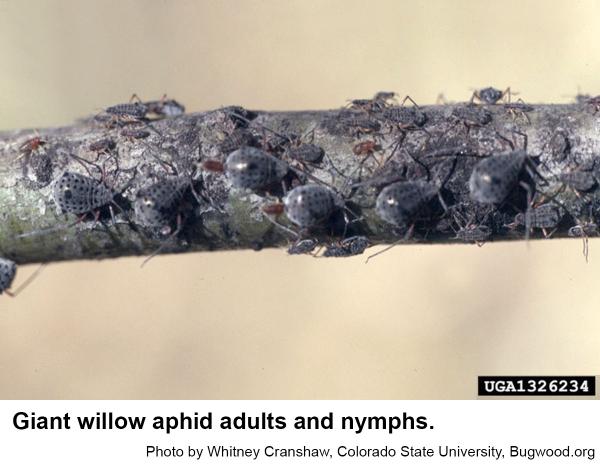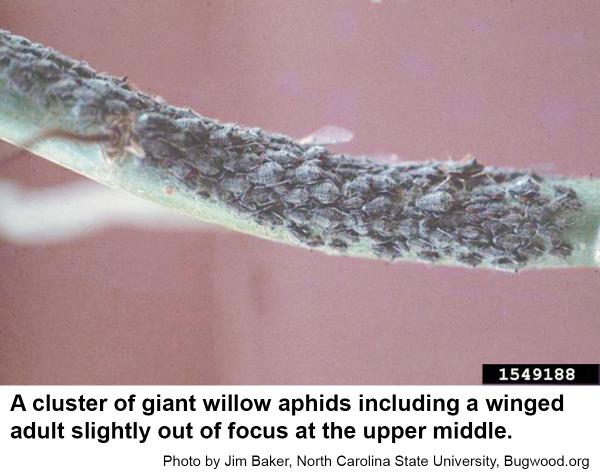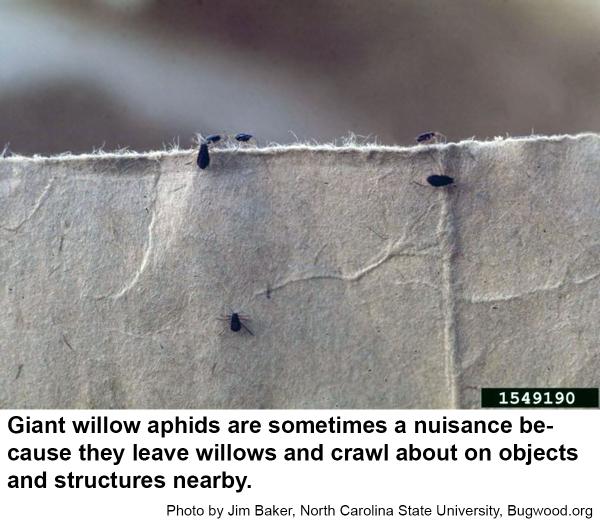Description and Biology
One of the most common aphid pests of willow is the giant willow aphid, Tuberolachnus salignus. This is one of our largest aphids. Adults are about ¼ inch long. These gray aphids have rows of small black spots down the body with three conspicuous larger black spots toward the tail. The middle spot is actually a raised cone that from the side resembles a shark fin (hence another common name: shark bug ). The antennae are relatively short, just half the body length. Nymphs are smaller but resemble their mothers and aunts. Giant willow aphids often appear in mid summer and become abundant in late summer or fall. Aphid populations often increase dramatically because they reproduce parthenogenetically (no males) and because they migrate into new areas from time to time. Each aphid can produce about 30 nymphs. Giant bark aphids are tolerant of cold temperatures and persist on willow bark well into February. Where they survive from late winter until mid summer is not known.
Host Plants
Appropriately enough, giant willow aphids readily infest most species of willow but sometimes spill over onto poplar.
Residential Recommendations
In warm weather, parasitic wasps, lady beetles, hover fly maggots, lace wings and other predaceous insects feed on aphids so that aphid populations often decrease rapidly as the weather warms up. Aphid populations are sometimes devastated by Cephalosporium lecanii, a fungus that infects aphids as a sort of super athletes' foot. This fungus is apparently more active in warm weather. For "organic" control of aphids, use an insecticidal soap or one of the horticultural oils. Because sooty molds grow in honeydew excreted by aphids consider using one of the horticultural oil because oils tend to cause the sooty molds to weather away more rapidly than do other pesticides. Systemic insecticides such as imidacloprid might be appropriate for some situations.
References
- Aphids on Ornamental Landscape Plants. Frank, S. 2009. Entomology Insect Notes, NC State Extension Publications.
- Host selection and performance of the giant willow aphid, Tuberolachnus salignus Gmelin - implications for pest management. Collins, C. M. et al. 2001. Agricultural and Forest Entomology (2001) 3, 1-8.
- Sooty Molds. Frank, S. et al. 2029 (revised). Entomology Insect Notes, NC State Extension Publications.
- Tuberolachnus salignus, Giant willow aphid. Anonymous. No Date. InfluentialPoints.com
- Extension Plant Pathology Publications and Factsheets
- Horticultural Science Publications
- North Carolina Agricultural Chemicals Manual
For assistance with a specific problem, contact your local N.C. Cooperative Extension Center.
This Factsheet has not been peer reviewed.
Publication date: July 27, 2016
Reviewed/Revised: May 11, 2021
Recommendations for the use of agricultural chemicals are included in this publication as a convenience to the reader. The use of brand names and any mention or listing of commercial products or services in this publication does not imply endorsement by NC State University or N.C. A&T State University nor discrimination against similar products or services not mentioned. Individuals who use agricultural chemicals are responsible for ensuring that the intended use complies with current regulations and conforms to the product label. Be sure to obtain current information about usage regulations and examine a current product label before applying any chemical. For assistance, contact your local N.C. Cooperative Extension county center.
N.C. Cooperative Extension prohibits discrimination and harassment regardless of age, color, disability, family and marital status, gender identity, national origin, political beliefs, race, religion, sex (including pregnancy), sexual orientation and veteran status.



